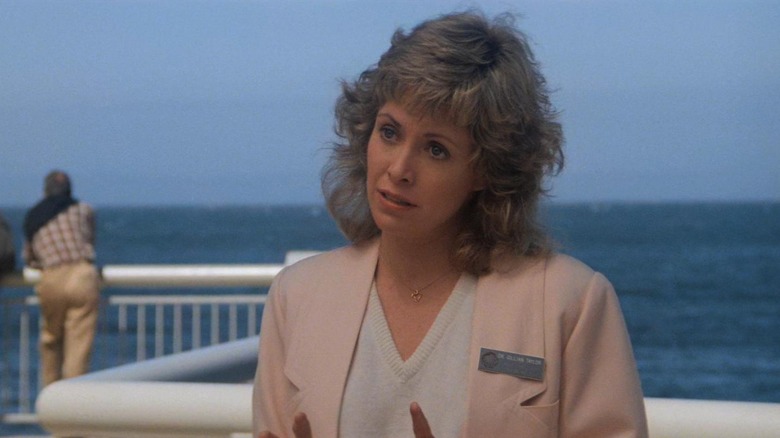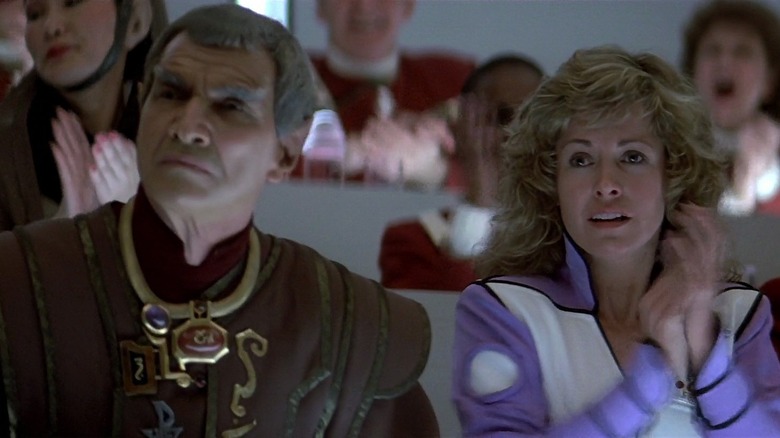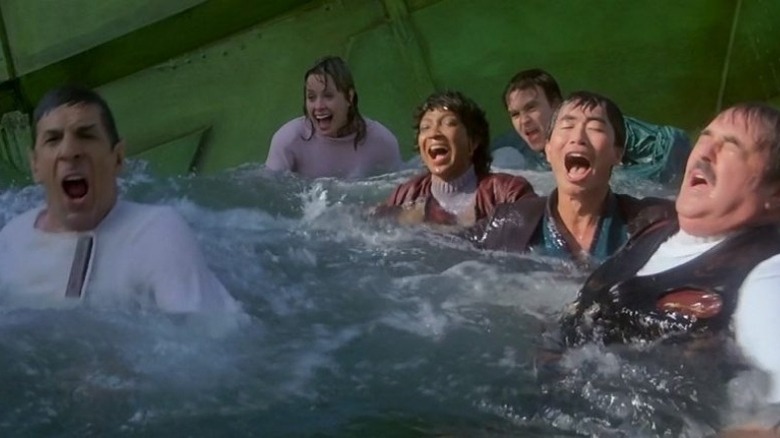Catherine Hicks Stood Up To William Shatner's Showboating On Star Trek IV: The Voyage Home
Both "Star Trek II: The Wrath of Khan" and "Star Trek III: The Search for Spock" ended poorly for the crew of the U.S.S. Enterprise. "Khan" did see the defeat of a vengeful villain and the reunion between Admiral Kirk (William Shatner) and his son David (Merritt Butrick), but it required the sacrifice of Spock (Leonard Nimoy) and the severe buffetting of the Enterprise itself. "Search" ended with the resurrection of Spock, but required the theft and the destruction of the Enterprise, as well as the death of David at the hands of vengeful Klingons. Spock was back, but Kirk was now a wanted criminal with no vessel to command.
It's no wonder, then, that the makers of "Star Trek IV: The Voyage Home" decided to affect a much lighter tone. "Voyage" saw the Enterprise crew, on board a clunky old Klingon vessel, traveling back in time to 1986 to rescue a pair of humpback whales from Earth. They aimed to return the whale to the future where they might communicate with a destructive, mysterious probe that was in the midst of emptying the planet's oceans.
Set mostly in present-day San Francisco, "Voyage" is predicated on fish-out-of-water humor and the chuckles elicited from seeing the otherwise stalwart Starfleet officers presented with a planet they don't understand. Kirk ends up developing something of an attraction from the outraged cetologist Dr. Gillian Taylor (Catherine Hicks). Dr. Taylor is smart enough to figure out that Kirk comes from space.
Speaking to StarTrek.com in 2012, Hicks recalled filming "Voyage" with William Shatner and found his habit of hogging the spotlight to be utterly annoying. Hicks said she would ultimately have to go over Shatner's head and directly address the film's director about getting some actual close-ups into the movie.
The Cetologist vs. the Admiral
Dr. Gillian Taylor is the one who explains to Admiral Kirk and Spock the plight that humpback whales face on 1986 Earth. They are being hunted to extinction, and Dr. Taylor is revolted. Spock points out that hunting a species to extinction is not logical. Dr. Taylor wisely points out that humans aren't a logical species. Later in the film, Dr. Taylor stows away on Kirk's transporter beam, eager to learn about future technology and to eventually return to the 23rd century, ready to explore the world Kirk described to her.
The interactions between Kirk and Dr. Taylor are casual and modern, lacking any sense of Starfleet propriety. She's a refreshing addition to the film. Hicks said she really loved shooting "Star Trek IV," and that everyone treated her with kindness. She only had one complaint, and it was Shatner's ego. It seems he always wanted to be on camera, demanding more close-ups than his co-stars. He also wanted to be on camera in two-shots, leaving Hicks without any chances to appear on screen by herself.
Hicks took her issue to Nimoy, the film's director. She said:
"I remember the fun, the kindness, just the kidding around, the joyfulness, and fighting for some close-ups, the tug of war with Bill (Shatner) for close-ups. It taught me to stand up for myself. I'd go to Leonard and say, 'This is MY shot. I need a single. I'm not going to share the shot with Shatner.' He wanted to get in every shot, but you couldn't get mad at him because he was like a devilish brother."
Stories of Shatner's ego are legendary, so Hicks seemed to weather the Shatstorm with aplomb.
Don't stop
Hicks had never worked on a film anything like "Star Trek IV" before. She admitted that she wasn't a Trekkie and knew utterly nothing about what "Star Trek" was. "I didn't know what beaming up meant," she said. Ultimately, however, Hick's ignorance of the franchise helped inform her character. Dr. Taylor, after all, was also supposed to be ignorant of the 23rd century and all its fineries.
In addition to standing up to Shatner's ego, Hicks also learned to act in an ensemble of actors who were all simultaneously engaged in action scenes. When asked her impressions of Nimoy as a director, Hicks recalled his direction to keep a scene going despite little screw-ups. It seems that Hicks, like many actors, still had a scrap of ego of her own, and Nimoy reminded her to be generous to the entire cast during action sequences. She said:
"Nimoy was very kind and actor-friendly, but the one note he gave me that happened to be strict, that taught me something, was when you're doing effects films, when they go, 'Action,' and a lot of stuff is going on, you don't stop the take just because you don't feel you're doing it right. He said, 'Just keep going. Don't stop. Don't stop everybody.' I remembered that because it's selfish just to stop."
Hicks never returned to "Star Trek," although Dr. Taylor was mentioned a few times in Trek's vast ocean of expanded universe lore. In the novel series "Department of Temporal Investigations," she was a key player, and was said to have authored a book called "Whales Weep Not: My 300-Year Voyage Home with George and Gracie." It seems that Dr. Taylor was happy with her time travel adventure.


